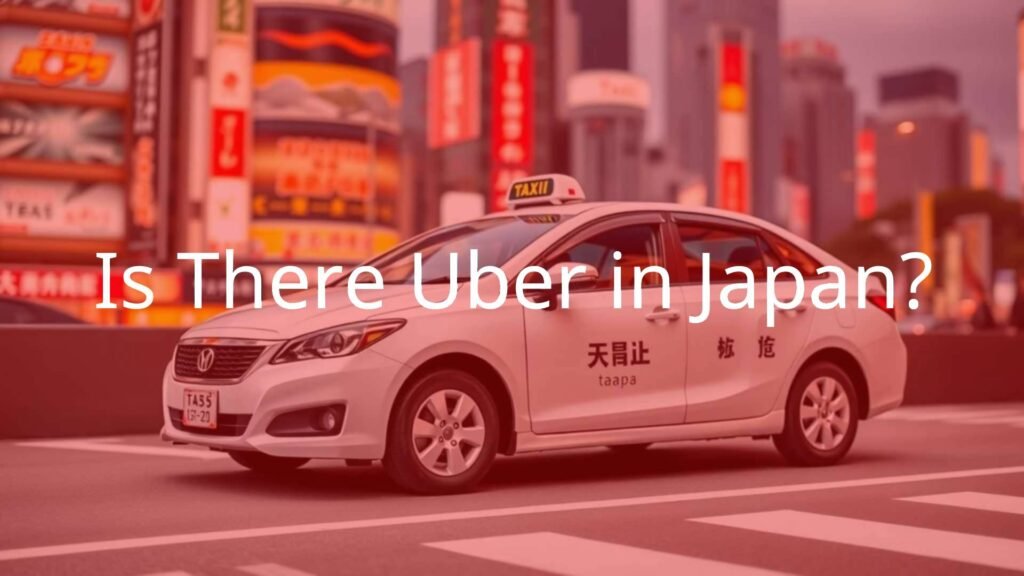Yes, there is Uber in Japan. But if you are expecting the same kind of Uber service you find in cities like New York or London, you should be aware that it works differently here. In Japan, Uber mostly helps you get a taxi, and not a ride from someone’s private car. This setup exists because of local laws and a strong taxi industry. In big cities, Uber can be useful, but it comes with rules and limits that both travelers and locals should know about.

Is There Uber in Japan?
How Does Uber Operate in Japan?
Uber is present in Japan, but it works in its own way. Instead of matching you with private drivers, Uber mainly connects you with licensed taxis. So, when you book an Uber, you are usually getting a normal Japanese taxi that just happens to use Uber’s app to find passengers. This is due to Japan’s strict rules for taxis, which do not allow private ride-sharing in the way other countries do.
By April 2025, Uber was available in 33 out of 47 prefectures. Still, you’ll find it is much more common in large cities. The app looks and feels about the same as elsewhere, but in Japan, it matches you with regular taxis according to transport rules. This lets Uber stay within local laws and still provide the easy booking many people want.
Why Is Uber Not Like Other Countries?
The main reason Uber is different in Japan is because of strict laws and a strong taxi business. Unlike in the US or Europe, in Japan, it is not legal for ordinary people to give rides for money through Uber. These rules meant Uber could not launch fully until 2018. It wasn’t until 2020 that Uber grew in Tokyo by partnering with cab companies. There was pushback from existing taxi drivers, who worried about prices and safety – concerns that have come up in other countries too.

Uber faces limits on when and where it can work. Depending on your location and the time, there may be few or no Uber vehicles available. In Japan, Uber is more of an extra way to book a regular taxi than a totally new kind of service. All drivers are fully licensed, and must have the proper licensing needed to carry passengers.
Which Cities in Japan Offer Uber Services?
Main Cities Where You Can Use Uber
Uber operates in many areas, but you’ll find it works best in Japan’s larger cities. These include Tokyo, Kyoto, Osaka, and Fukuoka. For example, in Tokyo, Uber works in popular spots like Shibuya, Shinjuku, and Roppongi. In Osaka, it’s common in areas like Namba and Umeda, especially where there are many businesses.

In Kyoto, Uber also works, but the number of available cars may be lower than in Tokyo or Osaka. Even in these cities, there can be rules about pickup places – like near busy train stations, you may need to meet your Uber on a nearby street instead of directly outside the station, while regular taxis can often pick you up right at the entrance.
Is Uber in the Countryside?
Outside the biggest cities, Uber is hard to find. While the company says it covers 33 prefectures, in rural or less-populated areas, Uber vehicles may be rare or simply not available at all. Wait times can be long and it may not be dependable for quick rides.
If you are traveling in these places, waving down a regular taxi or using a local taxi app like GO is usually easier. For many trips outside major cities, Japan’s trains and buses are more common, more affordable, and much more reliable.
What Kinds of Uber Services and Prices Are There in Japan?
There are two main Uber services in Japan: Uber Taxi and Uber Premium. Which one is offered depends on where you are. Both can be booked through the app, but they are targeted at different riders and have distinct prices.
Uber Taxi: What to Expect and How Much It Costs
Uber Taxi is the main service in Japan. It lets you use the Uber app to book a regular taxi from a company that partners with Uber. To use it, set your destination and pick “Uber Taxi.” You can see your ride coming and pay through the app, so you don’t need to carry cash-something many visitors like.
The price you pay is similar to what you would pay for a regular taxi, since Uber is just the booking tool. Your fare includes a starting fee, the distance shown by the meter, sometimes a booking fee (especially in Tokyo), and road tolls if any. The starting fee is usually between 300 and 400 yen and depends on the company’s pricing method. If you change where you want to be picked up or dropped off, your fare might also change.
Uber Premium: What to Expect and How Much It Costs
Uber Premium (also called Uber Black) gives you a higher level of service with nicer black cars and top-rated drivers. The vehicles usually hold up to five people and extra luggage. In Tokyo, you can even book a minivan that seats six, though this will have an extra fee of 1,090 yen for the larger car.
Uber Premium is more expensive than Uber Taxi. Its cost is based on how far and how long you travel, with extra charges possible at busy times. You see your fare in the app before you book. Once you finish, the app charges you automatically.
| Service | Type of Vehicle | Main Use | Typical Fare (15 min ride) |
|---|---|---|---|
| Uber Taxi | Standard licensed taxi | Everyday rides | Tokyo: ¥1,200 Kyoto: ¥550 Osaka: ¥770 Hiroshima: ¥700 |
| Uber Premium | Luxury vehicle (black car/minivan) | Group/luxury/extra luggage | More than Uber Taxi, varies by trip |

How Uber Prices Compare to Local Taxis
It’s important to know that Uber in Japan is not usually cheaper than a regular taxi. Prices are mostly the same as a normal taxi, plus a small booking fee for using the app. For example, both charge by the meter; Uber simply adds a convenience charge. At busy times, prices can get even higher than a standard taxi. If you are trying to save money, catching a taxi on the street or using public transport is usually a better deal.
How to Use Uber in Japan
Setting Up Your Account and Language Options
If you already have the Uber app from your home country, you don’t need a new one when you’re in Japan. The interface is easy and can be used in 50 languages, so it works well for most foreign travelers. You don’t need a Japanese phone number or a local credit card; your usual account is enough.
How to Book Your Ride
Booking an Uber in Japan is almost the same as in any other country. You do need a reliable internet connection. Open the app, enter where you want to be picked up and where you are going, then choose the service (often Uber Taxi or Uber Premium) and see the estimated cost. You can also plan your ride for later if you want.
How to Pay, and About Tipping
The main draw for many travelers is that Uber’s payments are all digital-you don’t have to use Japanese yen or do any currency exchange. Payments are automatic through your linked credit card. Tipping isn’t part of Japanese culture and is not expected, even if the Uber app asks.

Can You Use Uber at Airports?
Uber is available at Japan’s main airports (Narita, Haneda, Osaka’s Itami, Kansai International, and more). You can get an Uber to or from the airport. Still, Japan’s trains and other public transport are often easier and cheaper between the city and airports, except if you have lots of luggage or are traveling as a group. Uber is good for convenience, but not always the best value for these trips.
What Are Uber’s Limits in Japan?
Legal Restrictions
Uber’s biggest limits come from local laws. Unlike in some other countries, Uber cannot let private car owners give rides here. Only companies with taxi licenses and their drivers can offer rides through Uber. So, while you use the Uber app, you’re still getting a standard taxi under all the same government rules.
Area Limits
Uber’s reach is mostly in major cities like Tokyo, Kyoto, and Osaka. If you leave these cities, it will be much harder to find an Uber. Even within the city, there can be limits, like not being able to get picked up right outside certain train stations. In contrast, regular taxis can be found and hailed almost anywhere in a city.
About Uber’s Pricing
Another issue is that Uber often costs more than people expect. In Japan, Uber does not undercut regular taxi prices. The fares are the same as taxis, with an added booking fee. Busy times can mean even higher prices. For most people, Uber is a premium service in Japan rather than a money-saver.
Cultural Preferences and Competition
Japan’s public transport system-especially trains and subways-is famous for being safe, fast, and cheap, and many people prefer it over taxis. Regular taxis have trained drivers and are trusted. Local apps like GO have become more popular than Uber, especially outside the largest cities, because they partner with more taxi companies and cover more areas.
How Do Japanese Taxi Apps Compare to Uber?
Top Taxi Apps: GO, JapanTaxi, LINE Taxi, DiDi Japan
Uber has some presence, but local Japanese apps are often more popular and better connected to taxi fleets. The biggest is GO, with over 80% of the market and access to around 100,000 taxis. You book cabs through a map on your phone, pay online, and even book rides to airports at a fixed price or up to a week in advance.
Other apps include JapanTaxi, which is easy to use with credit cards; LINE Taxi, for people who already use the LINE messaging app (though usually just in big cities); and DiDi Japan, which has good language support but covers fewer cities. All of these apps let you book taxis cash-free and make the ride smoother if you don’t speak much Japanese.
Is Uber Cheaper Than Local Taxis?
No, Uber’s prices are not less than regular taxis in Japan. In fact, with the extra service fee for using the app, Uber can be a little more expensive-especially when demand is high. So if your main goal is to spend less, public transport or hailing a taxi without an app is usually a better choice. The main upside to Uber and other apps is the cashless payment and help with language barriers.
Helpful Tips for Visitors Thinking About Uber in Japan
Advice for Getting Around and Staying Online
If you visit Japan, it’s smart to use different types of transport. Japan’s trains and subways run smoothly and are cheap, especially in big cities. If you plan a lot of travel between cities, a Japan Rail Pass is a good buy. For city trips, a prepaid IC card like Suica or Pasmo works on trains, buses, and subways and saves time and money over taxis or ride-hailing apps.
To use Uber or other apps, you need steady internet access because a single Uber ride of about 25 minutes can use around 20MB of data. Renting a pocket Wi-Fi, using a local eSIM, or buying a travel SIM card are all good ways to stay online. It’s also a good idea to save offline maps as a backup.
When Does Uber Make Sense in Japan?
Uber is most useful:
- If you don’t speak Japanese: You simply type your location in English, and the app handles the rest for the driver. No need to give complicated directions.
- If you want to pay without cash: All charges go through the app, so you don’t need cash or worry about getting correct change.
- If you can’t find a taxi: Late at night or in rare areas, Uber may help by sending a taxi to your exact spot.
- If you need a bigger car: Uber Premium in Tokyo can arrange a minivan for large groups or those with lots of bags.
But for short trips in city centers, it’s quick and often less expensive to just hail a taxi. For journeys to and from airports or between cities, trains will usually be your best choice.

FAQs About Uber in Japan
Is Lyft Available in Japan?
No, Lyft does not operate in Japan. The main options are Uber (for taxi hailing), GO, and other Japanese taxi apps.
Can I Take Uber to a Faraway City?
You can book an Uber for long rides, but it costs a lot given the way Japanese taxi fares work. High-speed trains like the Shinkansen are much faster and cheaper for journeys between cities. For most people, Uber is just for short rides inside cities.
Does the Uber App Work Well in Japan?
The Uber app works smoothly in Japan, just as it does elsewhere. It supports English and many other languages, shows you the fare, and handles payments digitally. How well it works depends on whether there are any Uber-linked taxis nearby, so it’s best in big cities. You also need reliable internet access to use the app.
- What Is a Maiko? - July 13, 2025
- What Does Domo Arigato Mean? - July 12, 2025
- What Does Naruto Mean? - July 12, 2025









